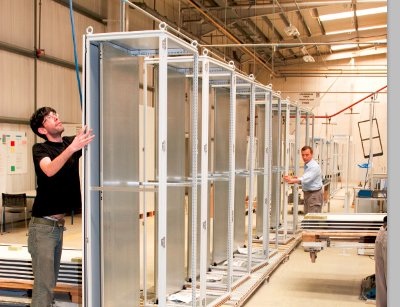Many specification engineers, system integrators and panel builders focus their upfront electrical system design to build exclusively on functionality, concentrating on how it will perform within the specification outlined by the end user.
Often the last thing to be taken into account in the electrical system integration is the system enclosure, future proofing, accessories and ancillaries. Choosing the right enclosure and its associated ancillaries for the application can have a huge impact on the overall performance and efficiency of the system’s operation and can significantly prolong the life of the installed equipment, save energy, utility costs and protect against unscheduled downtime.
With careful consideration and the right information, the correctly specified system enclosure and ancillaries can truly become an asset for increased productivity and profitability for the panel builder and system integrators, through to the end user.
Anyone can make a cabinet since technically it is not the most challenging product to produce. Clean rooms or sophisticated test equipment are not essential, all that is needed is the ability to be able to cut, punch, fold, weld, paint, assemble and pack the product.
Great enclosures, however, solve problems. There is, after all, nothing more frustrating than trying to fit out a cabinet when the practicalities of applications have not been recognized in the finished product. Examples include having scrapped your knuckles for the fifth time on a protruding edge, standing on a corner angle and bending it because of a lack of inherent strength and snagged cabling on a sharp corner as it enters into the cabinet.
Enclosure manufacturers design for the present challenges and requirements and future needs. This is why new design tools that have been implemented at Rittal’s UK manufacturing site at Plymouth allow the modern cabinet designer to not only build in 3D in a virtual world but also to test. Using finite analysis, the enclosure concept can be tested under different forces and frequencies to determine potential weaknesses before any metal is cut. There is no replacement, however, for load testing in the real world and therefore conducting drop tests is essential to validate the virtual tests.
Design is one thing, manufacturing quite another. The secret to good manufacturing can be summed up in the words ‘consistency’, ‘quality’, and ‘on time’. Automation is key to solving these three issues. Cabinets are no different, removing the human element, increases capacity and consistency and maintains quality. Automation comes with some restrictions such as ‘specials’, i.e. unusually placed holes with the cabinet painted green. This will typically be dealt with differently and will require a more labour intensive manufacturing process.
The slowest part of any manufacturing process is the paint line and ensuring that this is fully utilized is an exact skill of matching demand with multiple paint changes. Not a simple process, therefore having an onsite chemist is essential. Each raw cabinet component is firstly cleaned using a phosphate spray that fully removes the oils from the metal surface, then gets dipped into a wet paint tank ensuring 100% coverage, which means that it has a greater resistance to corrosion. The dipped component then enters the epoxy powder coating line and by applying an electric current to the enclosure component a magnetic field can be created. If the inverse of the magnetic field is then applied to the paint particles, the powder paint effectively sticks to the cabinet and by varying the charge you can vary the paint thickness applied. Once the component is coated, it is then put through an oven to ‘enamel’ it permanently. The powder coating not only provides a very efficient form of painting but where it is a dry powder means that it is easier to clean down the spray booth ready for a different colour.
Cabinets are then assembled to the customer specification and packed. Given that most damage occurs during transit of the enclosure from the manufacturing facility to the user, reducing the amount of transport is essential, not only to minimize potential for damage but also the impact on the environment. Packaging is a necessary evil and is expensive, so much design time and effort is spent ensuring that the packaging is not only fit for purpose, but also cost effective.
This article first appeared in FOCUS magazine’s Insert on Racks & Cabinets. To sign up for your digital editions, click here.

